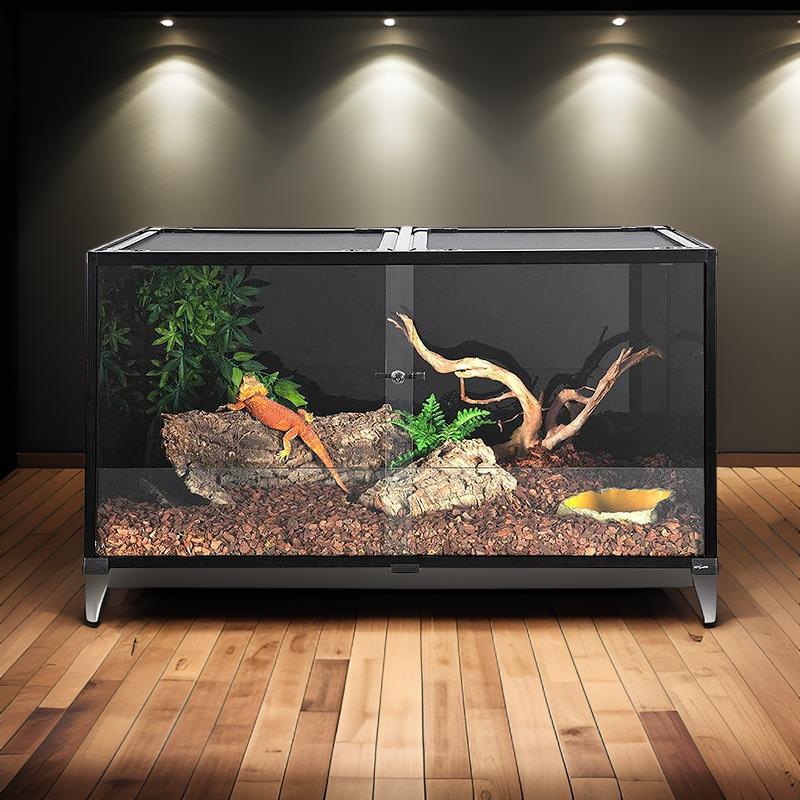How to Set Up a Bearded Dragon Habitat: A Step-by-Step Guide

A properly set up habitat is essential for the well-being of your bearded dragon. Since they come from the dry, warm deserts of Australia, it’s important to recreate similar conditions at home. In this guide, we'll walk through each step of setting up an ideal bearded dragon enclosure, including choosing the right tank size, heating, lighting, substrate, and accessories.
1. Choosing the Right Tank
Tank Size
Bearded dragons require ample space to move around, bask, and explore:
- Babies (up to 6 months): A 20-gallon tank works initially, but upgrading to a larger tank is a must as they grow quickly.
- Juveniles (6-12 months): A 40-gallon tank allows them enough room for activity.
- Adults (12+ months): At least a 75-gallon tank, though 100-gallon tanks are ideal for full-grown dragons.
Look for tanks with front-opening doors, as these make it easier to access and clean.
Recommended Tank Products
2. Setting Up Proper Lighting
Lighting is crucial for bearded dragons to synthesize vitamin D and process calcium, which prevents metabolic bone disease.
- UVB Lighting: Install a UVB tube light that covers about two-thirds of the tank length. Replace the bulb every 6-12 months to maintain UVB effectiveness.
- Basking Light: Bearded dragons need a basking area of 95-110°F. Position a heat lamp at one end of the tank to create a warm zone.
Recommended Lighting Products
3. Heating and Temperature Gradient
Creating a temperature gradient in the tank allows your dragon to regulate its body temperature. Here's how:
- Basking Zone: Maintain a temperature of 95-110°F for adult dragons, slightly lower for juveniles.
- Cool Side: The cooler end of the tank should be around 75-85°F.
- Night Temperature: Drop to around 65-75°F at night to mimic desert conditions.
Thermometers and Thermostats
Use a reliable thermometer or digital thermostat for both ends of the tank. This helps maintain consistent temperatures across your dragon's habitat.
4. Safe Substrate Options
Substrate, or tank flooring, plays a huge role in your dragon’s safety and cleanliness.
- Best Options: Reptile carpet, paper towels, and tile are safe, easy to clean, and prevent ingestion risks.
- Avoid: Sand, loose gravel, and wood chips. These can lead to impaction, a serious health risk when ingested.
Recommended Substrates
- Zoo Med Reptile Carpet (easy to clean, reusable)
- Slate Tile Flooring (naturalistic, can be found at home improvement stores)
5. Adding Décor and Enrichment
Bearded dragons love exploring, hiding, and climbing. Include these in the setup:
- Basking Rock or Log: Dragons need a spot to bask under the heat lamp. Look for a stable, non-slip surface.
- Hides: Place at least one hide in the cooler side of the tank for them to rest and de-stress.
- Branches and Climbing Areas: Add branches or driftwood to encourage exercise and natural behaviors.
Décor Product Ideas
6. Water and Humidity
Bearded dragons come from low-humidity environments, so keeping the tank dry is important:
- Water Bowl: Place a shallow water dish on the cooler side, refreshed daily.
- Humidity Levels: Keep humidity between 20-40%. Higher levels can cause respiratory issues.
To measure humidity, use a hygrometer placed near the water bowl.
Water and Humidity Accessories
Final Tips
Weekly Maintenance
Cleaning the tank regularly keeps your dragon’s habitat healthy:
- Spot Clean Daily: Remove waste, old food, and check water quality.
- Deep Clean Weekly: Remove all substrate, clean surfaces, and wash décor items with a reptile-safe disinfectant.
Monitor Your Dragon’s Behavior
Observe your dragon’s behavior to ensure they're comfortable. If they spend too much time in one area, the temperature gradient might need adjustment. Also, watch for signs of stress, like a blackened beard or lack of appetite.
Conclusion
Creating a cozy and safe habitat for your bearded dragon doesn’t have to be complicated, but it does require attention to their unique needs. A well-set-up tank will keep your dragon active, healthy, and happy, enhancing their quality of life and strengthening the bond you share.
Happy habitat building, and feel free to comment with any questions!
